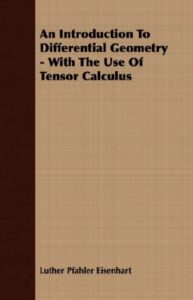AN INTRODUCTION TO DIFFERENTIAL GEOMETRY WITH USE OF THE TENSOR CALCULUS By LUTHER PFAHLER EISENHART. Preface Since 1909, when my Differential Geometry of Curves and Surfaces was published, the tensor calculus, which had previously been invented by Ricci, was adopted by Einstein in his General Theory of Relativity, and has been developed further in the study of Riemannian Geometry and various generalizations of the latter. In the present book the tensor calculus of cuclidean 3-space is developed and then generalized so as to apply to a Riemannian space of any number of dimensions. The tensor calculus as here developed is applied in Chapters III and IV to the study of differential geometry of surfaces in 3-space, the material treated being equivalent to what appears in general in the first eight chapters of my former book with such additions as follow from the introduction of the concept of parallelism of Levi-Civita and the content of the tensor calculus. Of the many exercises in the book some involve merely direct appli cation of the text, but most of them constitute an extension of it. In the writing of the book I have received valuable assistance and criticism from Professor H. P. Robertson and from my students, Messrs. Isaac Battin, Albert J. Coleman, Douglas R. Crosby, John Giese, Donald C. May, and in particular, Wayne Johnson. The excellent line drawings and half-tone illustrations were conceived and executed by Mr. John H. Lewis. Princeton, September 27, 1940 LUTHER PFAHLER EISENHART. In this edition a number of errors have been corrected in the text. On page 298 there are notes dealing with revisions not incorporated in the text. Princeton, April 9, 1947 LUTHER PFAHLER EISENHART. Contents CHAPTER I CURVES IN SPACE SECTION PAGE 1. Curves ami surfaces. The summation convention 1 2. Length of a curve. Linear element , 8 3. Tangent to a curve. Order of contact. Osculating plane 11 4. Curvature. Principal normal. Circle of curvature 16 5. TBi normal. Torsion 19 6r The Frenet Formulas. The form of a curve in the neighborhood of a point 25 7. Intrinsic equations of a curve 31 8. Involutes and evolutes of a curve 34 9. The tangent surface of a curve. The polar surface. Osculating sphere. . 38 10. Parametric equations of a surface. Coordinates and coordinate curves trT a surface 44 11. 1 Tangent plane to a surface 50 tSffDovelopable surfaces. Envelope of a one-parameter family of surfaces. . 53 CHAPTER II TRANSFORMATION OF COORDINATES. TENSOR CALCULUS 13. Transformation of coordinates. Curvilinear coordinates 63 14. The fundamental quadratic form of space 70 15. Contravariant vectors. Scalars 74 16. Length of a contravariant vector. Angle between two vectors 80 17. Covariant vectors. Contravariant and covariant components of a vector 83 18. Tensors. Symmetric and skew symmetric tensors 89 19. Addition, subtraction and multiplication of tensors. Contraction.... 94 20. The Christoffel symbols. The Riemann tensor 98 21. The Frenet formulas in general coordinates 103 22. Covariant differentiation 107 23. Systems of partial differential equations of the first order. Mixed systems 114 CHAPTER III INTRINSIC GEOMETRY OF A SURFACE 24. Linear element of a surface. First fundamental quadratic form of a surface. Vectors in a surface 123 25. Angle of two intersecting curves in a surface. Element of area 129 26. Families of curves in a surface. Principal directions 138 27. The intrinsic geometry of a surface. Isometric surfaces 146 28. The Christoffel symbols for a surface. The Riemannian curvature tensor. The Gaussian curvature of a surface 149 X CONTENTS 29. Differential parameters 155 30. Isometric orthogonal nets. Isometric coordinates 161 31...
In Collection
#928
Read It:
Yes
#928
Read It:
Yes
|
|
||||||||||||
